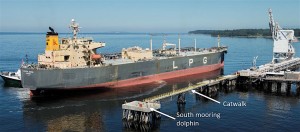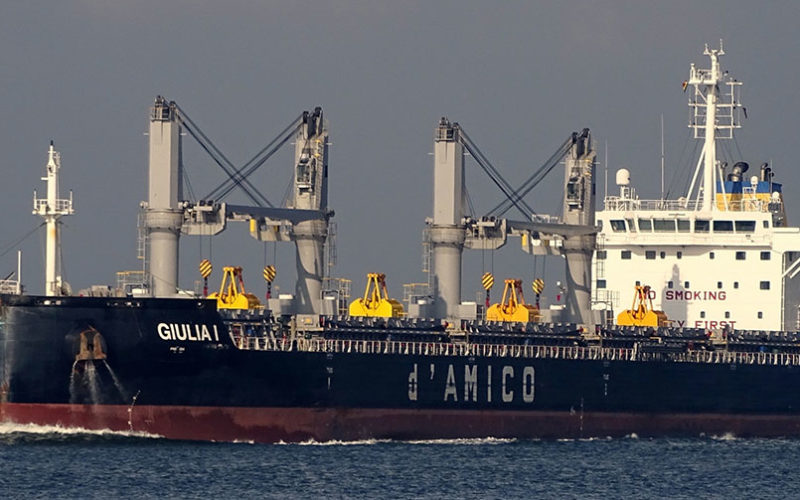
The loaded liquefied petroleum gas (LPG) carrier Levant was approaching the Petrogas wharf in Ferndale, Wash., when the pilot conning the ship recognized “something didn’t feel right.”
For the preceding two minutes, the master and Puget Sound pilot had engaged in a conversation unrelated to the docking maneuver. After noticing a problem, the pilot ordered the rudder hard to port, but by then the tanker was less than two ship lengths from the terminal and moving at more than 4 knots. As such, the order came too late.
Levant’s bow hit the wharf’s south mooring dolphin at 0406 on Dec. 15, 2019. The impact destroyed the dolphin and a catwalk, which collapsed into the water, and the ship’s hull was breached below the waterline. No pollution or injuries were reported, but the tanker sustained $1.5 million in damage and the terminal required $6.7 million in repairs.
National Transportation Safety Board (NTSB) investigators determined the ship’s speed and steep approach angle were primary factors in the accident. But they also cited the lack of effective discussion about the maneuver between the pilot and Levant’s bridge crew.
“While both the master and (officer on watch) thought they understood the pilot’s intended approach and use of tugs and speed, it was based on their assumptions rather than a communicated plan,” the NTSB report said, adding that there was “no shared mental model.”
“Additionally,” the agency said, “both the pilot and master were likely distracted by a non-pertinent conversation about three minutes before the contact.”
The Puget Sound Pilots did not respond to an inquiry about the NTSB findings. Levant operator Exmar Ship Management, based in Antwerp, Belgium, also could not be reached for comment.
The Marshall Islands-flagged Levant initially arrived at Petrogas from Ulsan, South Korea, late on Dec. 10, 2019. The ship loaded liquefied butane and propane for nearly three days. The master halted loading during the evening of Dec. 14 due to concerns about under-keel clearance in the Strait of Georgia’s ebbing tide.
The pilot arrived on Levant’s bridge at about 1930 that evening to shift the ship to an anchorage seven-tenths of a mile away. The pilot and master had a detailed discussion of the maneuver, including water depths, the use of tugboats and the anchoring plan. The maneuver was completed at 2050, the NTSB said.
The same pilot stayed aboard Levant for the return trip to the gas terminal at about 0400 the next morning. The master and pilot each reported getting at least 4.5 hours of sleep. The two met on the bridge at 0338.
This time, there was no detailed discussion about the maneuver before the ship got underway. The pilot confirmed that the tugboats Garth Foss, which made fast off the port bow, and Lindsey Foss, with a line centerline aft, would be used “same as before” but otherwise did not indicate his plan for the maneuver.
Levant got underway at 0354, with the pilot’s order of dead slow ahead and rudder 30 degrees to starboard at a gyro heading of 058 degrees. Both tugboats had lines secured on the ship by 0358. At 0401, the ship was moving at a speed of 4.3 knots over ground at a heading of 065 degrees. For the next two minutes, the captain and master engaged in a conversation about “non-navigational, non-operational matters,” according to the NTSB.
“At 0403, with a heading of 066 degrees and a speed of 4.5 knots, the pilot ordered the rudder hard to port,” the report said. The pilot walked briskly to the starboard bridge wing for a look toward the terminal. “A few seconds after the hard-to-port helm order, the operator of Garth Foss called the pilot on Levant asking him for orders, to which the pilot replied to stand by.”
At 0405, the ship was moving at 4.5 knots when the pilot ordered the engine stopped. He asked a lookout to gauge the distance to the south mooring dolphin, which the pilot could not locate. The pilot ordered the 7,600-hp Lindsey Foss to pull back before he got an answer, then ordered the ship’s engine dead slow astern as Levant closed with the dolphin.
Crew positioned on deck reported the ship’s distance from the mooring dolphin over the next minute. The ship was moving at 4.3 knots at a heading of 043 degrees when its portside bow hit the dolphin’s southeast side. The ship backed away with tugboat assistance after the impact and ultimately anchored about 1.5 miles away.
NTSB investigators determined there were no issues with the ship’s machinery or navigational equipment before the accident. Construction on the Petrogas wharf left the catwalk floodlights inoperative, although other segments of the structure were illuminated. Investigators could not determine if a yellow flashing navigation light on the south dolphin was working that morning.
Terminal workers noticed the ship’s speed and awkward approach angle well before the impact. One said the ship was “coming in pretty hot,” while another said it was “facing the wrong direction” by having its bow pointed east-northeast. Ships typically come north and line up along the terminal, then use tugs to push them into position, the report said.
Investigators highlighted the master’s authority and overall responsibility for the ship even though the pilot had the conn. Yet there was no indication the master recognized the ship’s predicament until the pilot did, and at that point it was too late to avoid the impact.
“In this circumstance, a condition of complacency likely existed with the pilot and bridge team because of the short distance back to the wharf,” the report said. “The vigilance of a pilot and bridge team should be increased, not decreased, with a ship’s proximity to dangers and obstructions.” •
Casey Conley

